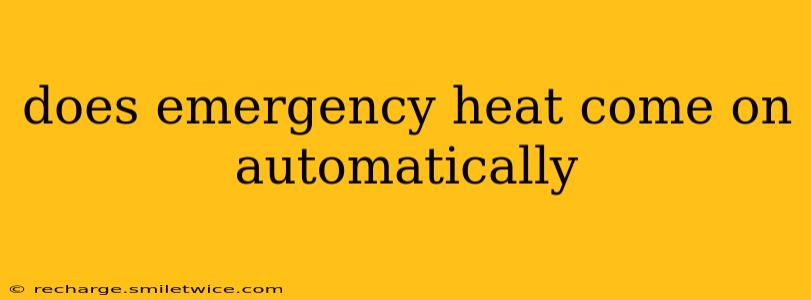Does Emergency Heat Come On Automatically? Understanding Your Heating System
Many homeowners wonder, "Does emergency heat come on automatically?" The answer isn't a simple yes or no. It depends on your specific heating system, its settings, and whether a problem triggers the emergency heat function. Let's delve into the details to help you understand how this crucial safety feature works.
What is Emergency Heat?
Emergency heat is a backup heating mode found in most heat pumps. Unlike the normal heating cycle, which uses a refrigerant to transfer heat, emergency heat utilizes electric resistance heating elements. Think of it as a secondary, less efficient, but always-available heating option.
Does Emergency Heat Turn On Automatically? The Role of Your Thermostat
The short answer is: usually not automatically. While emergency heat is designed as a backup, it doesn't typically activate on its own. Instead, it kicks in when your heat pump's primary heating system malfunctions or struggles to maintain the desired temperature. This can be due to several factors, including:
- Extremely cold temperatures: When outside temperatures plummet below the heat pump's operational limits, it may switch to emergency heat to provide at least some warmth.
- Frozen coils: Ice buildup on the outdoor unit's coils can severely reduce efficiency, prompting the system to switch to emergency heat.
- System malfunctions: A malfunctioning compressor or other internal component can trigger a switch to emergency heat as a failsafe.
- Thermostat Settings: While not strictly automatic, your thermostat's settings play a crucial role. If your heat pump can't keep up with the demand due to its settings, it might switch to emergency heat.
How Do I Know if My Emergency Heat is On?
Several signs indicate your system has switched to emergency heat:
- Higher energy bills: Emergency heat is significantly less efficient and will drastically increase your energy consumption.
- Reduced airflow: You might notice less airflow from your vents compared to normal heating operation.
- Thermostat display: Your thermostat should clearly indicate when the system is in emergency heat mode (often displaying "Electric Heat" or a similar message).
- Loud noises: You might hear louder buzzing or humming sounds from the indoor unit due to the electric heating elements working.
Why is My Heat Pump Using Emergency Heat All the Time?
If your heat pump frequently or constantly uses emergency heat, it's a serious issue requiring professional attention. This could indicate:
- Refrigerant leaks: A low refrigerant charge significantly impairs the heat pump's ability to operate effectively.
- Faulty compressor: A malfunctioning compressor is a major cause of frequent emergency heat usage.
- Dirty air filters: Clogged air filters restrict airflow and reduce the heat pump's performance.
- Frozen coils: Repeated freezing requires addressing the underlying cause, such as poor insulation or airflow problems.
What Should I Do if My Emergency Heat is Frequently Activated?
Don't ignore persistent emergency heat usage. Contact a qualified HVAC technician for diagnosis and repair. Ignoring the problem could lead to further damage, higher energy bills, and complete system failure.
Can I Manually Turn On Emergency Heat?
While not advisable for continuous use due to its high energy consumption, you can usually manually select emergency heat on your thermostat, particularly useful in case of a power outage (although this also depends on the wiring) to provide some level of heat. However, this should only be a temporary solution while awaiting professional repairs.
This detailed explanation addresses the common question of whether emergency heat activates automatically, exploring the nuances and factors involved. Remember, regular maintenance and prompt professional service are crucial for ensuring your heating system operates efficiently and safely.
